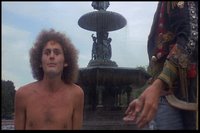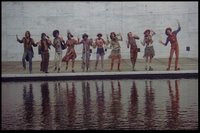Godspell (1973) Scene Guide
 In finishing my 30-film scene guide spreadsheet, I recently revisited Godspell (1972). The film calls itself "A Musical Based Upon The Gospel According To St. Matthew", and so I have prioritised referencing Matthew’s gospel rather than Mark’s as I normally do. I've also listed the times, and the song titles are italicised.
In finishing my 30-film scene guide spreadsheet, I recently revisited Godspell (1972). The film calls itself "A Musical Based Upon The Gospel According To St. Matthew", and so I have prioritised referencing Matthew’s gospel rather than Mark’s as I normally do. I've also listed the times, and the song titles are italicised.[0 min] Prologue - (Gen 1)
[1 min] John the Baptist - (Matt 3:1-12)
Prepare ye the way of the Lord
[9 min] Baptism of Jesus - (Matt 3:13-17)
Save the people
[14 min] Fulfil the Law - (Matt 5:17-20)
[17 min] Pharisee & Publican - (Luke 18:10-14)
[18 min] Settling Disputes - (Matt 5:23-26)
[19 min] Unmerciful Servant - (Matt 18:23-35)
Day by day
[24 min] Eye for Eye - (Matt 5:38-42)
[25 min] Sheep and Goats - (Matt 25:31-46)
[27 min] Lamp for the Body - (Matt 6:23)
[28 min] Two Masters - (Matt 6:24)
Turn Back O Man
[33 min] Good Samaritan - (Luke 10:30-37)
[35 min] Giving Alms - (Matt 6:1-4)
[36 min] Rich Man & Lazarus - (Luke 16:19-31)
Bless the Lord
[42 min] Beatitudes - (Matt 5:3-12)
All for the Best
[49 min] Love your Enemies - (Matt 5:43-48)
[50 min] Parable of the Sower - (Matt 13:3-8, 18-23)
All Good Gifts
[53 min] Consider the Lilies - (Matt 6:28-30)
[56 min] Prodigal Son - (Luke 15:11-32)
[62 min] Ask Seek & Knock - (Matt 7:9-12)
[63 min] You are the Light of the World - (Matt 5:13-16)
Light of the World
[65 min] Question on Authority - (Matt 21:23-27)
[66 min] Taxes to Caesar - (Matt 22:15-22)
[67 min] Greatest Commandment - (Matt 22:34-40)
[67 min] Seven Woes - (Matt 23:1-39)
Alas for You
By my Side
[74 min] Betrayal of Judas - (Matt 26:14-16)
Beautiful City
[78 min] Last Supper - (Matt 26:17-35)
On the Willows
[84 min] Gethsemane - (Matt 26:36-46)
[85 min] Temptation - (Matt 4:1-11)
[86 min] Arrest - (Matt 26:47-56)
[88 min] Death - (Matt 27:45-50)
[92 min] Burial - (Matt 27:57-61)
Long Live God
 The first thing that is obvious from the above is that not all of the incidents and quotes come from Matthew’s gospel. In addition to two of the songs being loosely based on Psalms, a number of pieces of teaching that are included are from Luke’s gospel. This has led Richard Walsh to claim that the film is more of a version of Q than of Matthew, as it also contains no birth narratives, miracles or prophetic actions. The argument is a little more complicated than that, but even in this simplified form it’s an interesting observation. Certainly, it's one of the Jesus films with the least amount of "action", and no miracles.
The first thing that is obvious from the above is that not all of the incidents and quotes come from Matthew’s gospel. In addition to two of the songs being loosely based on Psalms, a number of pieces of teaching that are included are from Luke’s gospel. This has led Richard Walsh to claim that the film is more of a version of Q than of Matthew, as it also contains no birth narratives, miracles or prophetic actions. The argument is a little more complicated than that, but even in this simplified form it’s an interesting observation. Certainly, it's one of the Jesus films with the least amount of "action", and no miracles.Despite the ongoing popularity of the stage show, the film itself is generally poorly regarded, due to the extent to which it has dated, and the campiness of the film. One other weakness is the way which the script inadvertently breaks the natural narrative arc of the gospel story. Jesus’s confrontation with the religious authorities is depersonalized – his harshest critic is a bizarre robotic creature. The ruling authority is represented by the police, but it is unclear why they wish to see him dead, or how they manage to electrocute someone on a fence (particularly when they are not in contact with the ground). In short Jesus’s death is stripped of its meaning, and is not invested with any new meaning. He appears to die for no other reason than that is what happened in the original story.
 That said, the way the burial / resurrection is handled is far more interesting. Whilst it denies the traditional resurrection, it does visualise a more Bultmannian theory on the resurrection. For Bultmann and those who developed his theories, Jesus remained dead, but the stories of his life were carried to the people, and inspired them with his continuing presence. Here we see Jesus remain dead, but his followers literally carry his body onto the deserted streets of New York. Suddenly as they round a corner they merge into a huge crowd that has suddenly appeared. It's not my personal view of the resurrection, but it's one that has a certain degree of theological insight.
That said, the way the burial / resurrection is handled is far more interesting. Whilst it denies the traditional resurrection, it does visualise a more Bultmannian theory on the resurrection. For Bultmann and those who developed his theories, Jesus remained dead, but the stories of his life were carried to the people, and inspired them with his continuing presence. Here we see Jesus remain dead, but his followers literally carry his body onto the deserted streets of New York. Suddenly as they round a corner they merge into a huge crowd that has suddenly appeared. It's not my personal view of the resurrection, but it's one that has a certain degree of theological insight.This is one of only three films to cover the story of the Rich Man and Lazarus, the other two being Il Messiah, and The Revolutionary. It's an interesting parable, not least because many hold it was one Jesus adopted and put a twist into his adaptation, rather than an original. The setting for this parable is one of the high points of the film visually, using a long stair case which extends from an underground room, to the top of a monument. The camera shots up the steps from the rich man's point of view underground are impressive.
 This is also the only Jesus film that includes the sayings about the sheep and the goats. It is interesting, however, how the film undermines the harsh nature of the original story in its retelling. Once Jesus completes the story "the goats" to come and join the others.
This is also the only Jesus film that includes the sayings about the sheep and the goats. It is interesting, however, how the film undermines the harsh nature of the original story in its retelling. Once Jesus completes the story "the goats" to come and join the others.There are a host of Godspell sites and resources out there, both about the musical and the film. In particular, the full (musical) script (rather than just the song lyrics), and a whole host of photos.
Labels: Godspell, Scene Guides














7 Comments:
At 11:24 pm, April 05, 2007, Anonymous said…
Anonymous said…
Fantástico, te enlazo.
Saludos
At 9:40 am, April 10, 2007, Matt Page said…
Matt Page said…
Thanks
Matt
At 7:11 pm, March 30, 2014, Anonymous said…
Anonymous said…
I love this movie since I was a child.
At 7:24 pm, October 01, 2017, Coracleman said…
Coracleman said…
It's been a while, but I've only just discovered your site which looks very interesting. I love Godspell, and your thoughts are very detailed and take an approach I've not seen before. I feel you are too literal at times. Electrocution? They weren't using the fence as the method, surely the scene is a representation of the cross and the red ribbons of blood don't fit electrocution. Meanwhile, what were the Temple Guard if not the police force of the day, up to a point. And in relation to Q it's interesting to note that the Matthew reference was not from Tebelak who used all the gospels as source material but was added to give the poster more weight apparently (Godspell: inside a transformative musical, Carol de Giere, 2014).
I'm intrigued by your thoughts on the resurrection. Most often it's said just to be missing (you say that yourself elsewhere) and picking up on the resurrection moment is important, yet for me that combination of the body with 'long live God' leading into 'prepare ye' symbolises the resurrection beautifully (fully, not just figuratively). i was struck by your point that the (for me) living Christ is then taken into the heart of the populated city streets. I hadn't really picked up on that before.
Thank you for an interesting blog and that Jesus film scene list will be interesting too.
At 4:48 pm, July 06, 2018, Anonymous said…
Anonymous said…
I'm a huge fan of the movie Godspell.
Sweet Lady
At 2:35 am, January 18, 2019, colliric said…
colliric said…
The point of the movie and musical it is based on was to focus on the overall Teachings and love of Jesus and reflect on how they are still relevant in today's modern world. So the lack of a dramatization of the miracles of Jesus is expected from the opening scene onwards.
I disagree with the statement about his Crucifixion in this review. He was murdered by the Sanhedrin because of his teachings of subversion and their/our sinful pride. The Sanhedrin or Jewish Establishment isn't depersonalized, the movie and musical simply correctly assumes you understand what is being represented in the visual metaphor. It correctly assumes you've read the Gospels and know which group it was coming after him.
He died for our sins. This fact is well represented and respected in the film. The John-Judas character is the Audience "representative", being both devoted loving disciple and sinful angry betrayer. He represents what our collective sinfulness resulted in.
At 5:13 pm, January 28, 2019, Matt Page said…
Matt Page said…
Thanks for your comment. I guess, for me, the metaphor has to work in the story as well as being a "code". But if you don't find that a problem then that's fair enough! I'm glad you obviously seem to enjoy it.
Matt
Post a Comment
<< Home